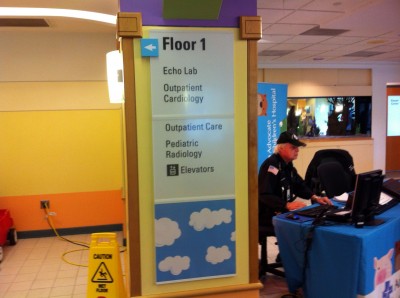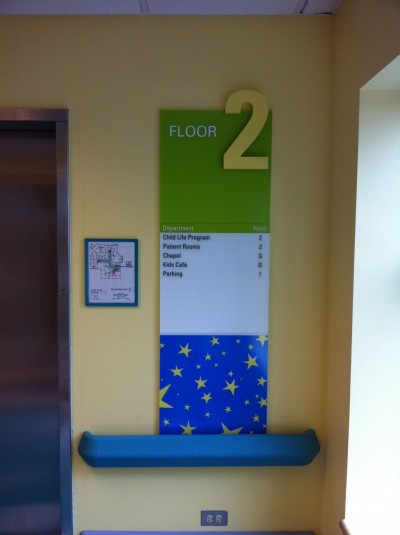
An effective sign system can help prevent hospital staff from having to spend thousands of hours each year answering visitors’ questions.
There are also challenges with regard to choosing the most appropriate wayfinding language. Indeed, a common pitfall for health-care wayfinding programs is the failure to communicate with patients in terms they can easily understand.
Traditionally, the naming of various health-care departments, facilities and other destinations has relied on medical terminology, including designations for specific practice areas and specialties. Unfortunately, this naming process comprises terms that are arcane and unfamiliar—and sometimes even frightening—to the first-time hospital visitor. Most people do not know ophthalmology, for instance, refers to eye care.
Better wayfinding demands a different, simpler approach to health-care language. Primary destinations should be labelled alphanumerically. This way, if visitors arrive pre-informed of their key starting points (e.g. parking lot or main building), they can simply follow a series of signs. At each point closer to their destination, additional alphanumeric listings are provided (e.g. elevator, floor and room designations) with reference to the department or office they seek.
Alphanumeric naming and progressive disclosure can simplify communications significantly. Since both practices require fewer instructions to be viewed and remembered by the visitor, signs end up with more space for larger type, which in turn means greater legibility for visitors, patients and staff alike.
The challenge of this approach, however, is first making sure patients receive the orientation details for an upcoming appointment, including a clear name of their destination, before they actually need to arrive on-site. This is important because—unlike airports with relatively obvious paths and destinations—hospitals and other large-scale health-care facilities are generally ‘blind labyrinths’ with no architectural clues to the correct path. Signs are crucial, but knowing the wayfinding system’s language first is also crucial.
So, to ensure people understand where they are going, information needs to be communicated to them in advance of their visit. There are many possible tools for this purpose, including appointment reminders, brochures, websites, mobile wayfinding apps and phone call reminders. It is essential for all of these communications tools, as well as the facility’s signs, to share a common wayfinding language.
Advocating clarity
This concept of using comprehensive wayfinding instructions to orient patients well in advance of their visit has already proven highly effective. It offers an opportunity to share the facility’s wayfinding language while also directly informing a patient how to get to an appointment.
One successful example is Advocate Children’s Hospital in Chicago, Ill., which recently commissioned a wayfinding master plan (WMP) to enhance facility navigation for its customers, in conjunction with a new branding program. The recommended WMP included a wide variety of communications tools for patients, visitors and staff.
The foundation of the program was predicated on providing simple step-by-step directions that correspond to Advocate’s organizational structure and the naming of its facilities. Prior to an appointment, tools for informing patients about how to get to their destination would include:
- a simple, printed wayfinding brochure for Advocate Children’s Hospital with a map showing each building’s name and location.
- a standard-format appointment card, digitally customized with more specific step-to-step instructions based on the exact appointment location.
- an appointment e-mail, providing instructions in clear wayfinding language.
- an optional appointment text message, delivering the same step-by-step instructions, but in a more simplified format.
Further, while at home or at work before their appointment, patients could visit the hospital’s website, where a wayfinding menu would list departments and their corresponding directions. It was also important to train—using a simple, web-based program—the hospital’s call-in staff to use consistent ‘appointment scripting’ when providing directions to visitors over the phone.
The WMP also recommended a wayfinding mobile app, whereby patients could refer to relevant information as they moved along their path, including details about specific parking zones, buildings and departments. Signs along their route, meanwhile, would use the same wayfinding language throughout the system, in roughly the following order:
- off-site directional traffic signs.
- building identification (ID) branding.
- campus markers.
- on-site directional traffic signs.
- directional parking signs.
- parking area ‘flags.’
- outpatient entrance markers.
- primary indoor directional signs.
- outpatient lobbies.
- departmental directories.
- elevator directories.
- secondary indoor directional signs.
- department ‘flags.’
- department and room ID signs.






